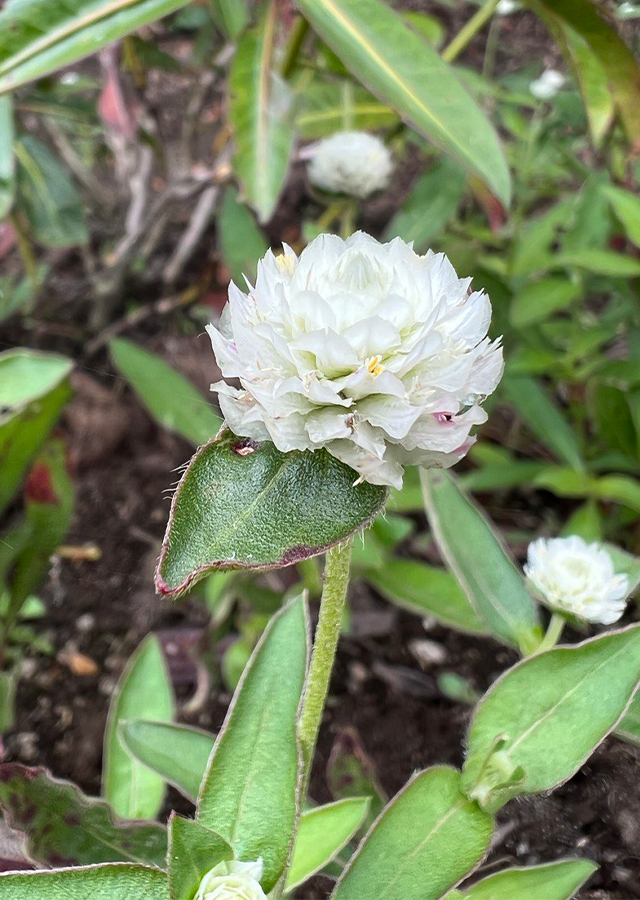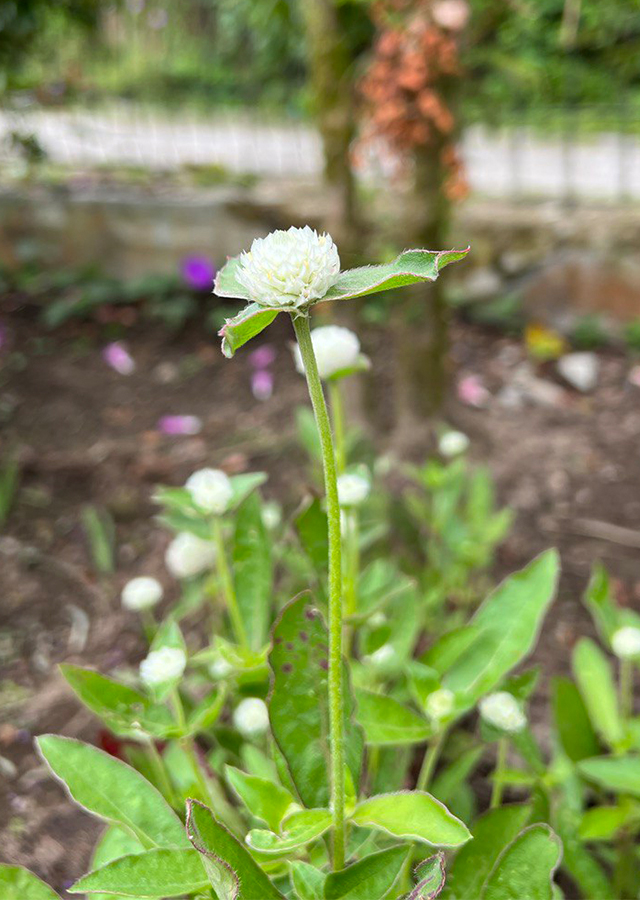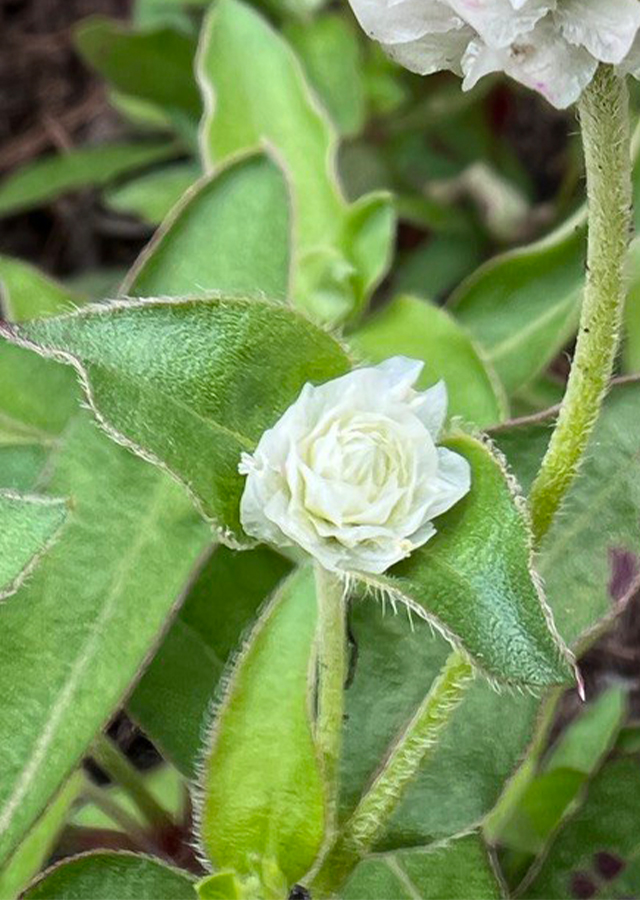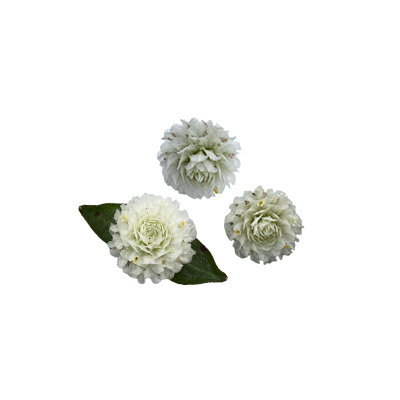Gomphrena Weed
Gomphrena celosioides Mart.
Amaranthaceae
Location in our garden
Principal



Synonym
Gomphrena alba Peter
Gomphrena celosioides var. aureiflora Stuchlík
Xeraea celosioides (Mart.) Kuntze
Habitus
Herbaceous. A prostrate or sprawling annual or perennial plant about 20 to 60 cm long.
Part Used
Leaves
Roots
The Whole Plant
Growing Requirements
Full Sunshine
Need Shade
Habitat
Riverbanks
Terrestrial
Overview
Gomphrena celosioides is native to Brazil, Paraguay, Uraguay and Argentina but has spread throughout the subtropic and tropic areas. Study for proximate composition and vitamin content of various parts suggest they are very nutritious and can contribute significantly to human health requirements.
Vernacular Names
Lebolomo la naga (Afrikaans), Ji guan qian ri hong, Yin hua xian (Chinese), Neervadamali (Malayalam-India).
Agroecology
Found in waste places, along roadsides, and in moist grassland areas, often mat-forming. Grows in the altitude range of 400-1,600 m. Prefers full sun with moderate water.
Morphology
- Roots - thick fleshy taproots.
- Stems - ascending to erect, striate and white silky hairy, the older ones smooth.
- Leaves - simple, opposite, 2 to 4 cm long, 1 cm wide, tapering on both ends, elliptical with smooth edges.
- Flower - bisexual, stalk bears white globose, ovoid, or cylindrical heads, densely covered with persistent white bracts giving the entire cluster an elongated look.
- Fruit - dry, indehiscent fruit is known as a utricle. Fruits are approximately round and each contains one seed.
- Seed - brown, glossy seed,1.5 mm long.
Cultivation
Generative propagation is by seed, and vegetative propagation is by stem cutting.
Chemical Constituents
Steroids, glycosides, alkaloids, saponins, polyphenols, flavonoids, triterpenes, aurantiamide, aurantiamide acetate, lipids, phenols, and tannins.
Traditional Medicinal Uses
- In Nigeria, the plant is used to treat skin and worm infections, as well as induce abortion.
- In South America, decoction of whole plant, together with G. globosa, is applied to wounds.
- In Trinidad and Tobago, plant is used to treat diabetes, hypertension, kidney problems, and as heart tonic.
- In Africa, it is used for treatment of jaundice and malaria. In Togo, west Africa, used for treatment of hepatic diseases.
- In India, whole plant juice along with Piper nigrum and lemon juice taken twice daily for 10 days to cure urolithiasis.
- In South Africa, roots are used as part of mixtures for treatment of diabetes mellitus. Leaves and leaves boiled and used in mixtures for treatment of sexually transmitted diseases.
- Studies have suggested antibacterial, antifungal, antioxidant, analgesic, anti-inflammatory, anthelmintic, hepatoprotective, nephroprotective, anti-ulcerogenic, anti-urolithiatic, anticarcinogenesis, antioxidant, and diuretic properties.
Part Used
Reference Sources
- Dosumu, O.O., Onocha, P., Ekundayo, O., Ali, M. (2014). Isolation of Aurantiamides from Gomphrena Celosioides C. Mart. Iranian Journal of Pharmaceutical Research,13(1) (pg.43–147). https://www.ncbi.nlm.nih.gov/pmc/articles/PMC3985246//. 09-11-2021.
- National Park of Singapore. (2021). Flora & Fauna Web: Gomphrena celosioides Mart. https://www.nparks.gov.sg/florafaunaweb/flora/6/6/6613. 09-11-2021.
- HEAR. (2010). Pacific Island of Ecosystem at Risk: Gomphrena celosioides. http://www.hear.org/pier/species/gomphrena_celosioides.htm. 09-11-2021.
- Royal Botanic Gardens. (2021). Plants of the World Online: Gomphrena celosioides Mart. http://powo.science.kew.org/taxon/urn:lsid:ipni.org:names:60397-1. 09-11-2021.
- Stuart Xchange. (2018). Philippine Medicinal Plants: Botonsilyong gapang Gomphrena celosioides C. Mart. http://www.stuartxchange.org/BotonsilyongGapang. 09-11-2021.
- Zimbabwe Flora. (2018). Flora of Zimbabwe: Gomphrena celosioides Mart. https://www.zimbabweflora.co.zw/speciesdata/species.php?species_id=122560. 09-11-2021.



